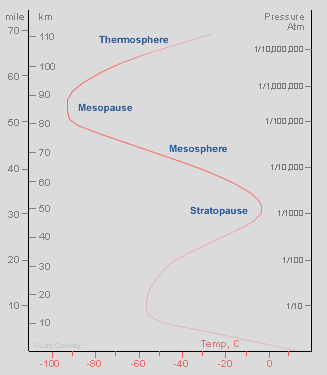Mesosphere & Mesopause
Mesosphere & Mesopause: Exploring the Middle Atmosphere
The mesosphere, also known as the 'middle atmosphere,' extends above the stratosphere's temperature peak at 50 km. As we ascend into this region, temperatures begin to drop significantly. In fact, the base of the mesosphere experiences a pressure that is only 1/1000 of that at sea level, and when we reach the top at 95 km, it becomes a mere millionth of sea-level pressure. Essentially, the mesosphere can be considered a vacuum for practical purposes.
In the mesosphere, temperatures play a crucial role in influencing molecular physics and chemistry rather than having the ability to heat objects like spacecraft or dust particles. The temperature decrease with height in this region is primarily due to the diminishing effect of ultraviolet absorption by ozone and the cooling impact of carbon dioxide. While in the lower atmosphere, carbon dioxide acts as a greenhouse gas by absorbing infrared radiation emitted by the Earth's surface, in the rarified mesosphere, it actually cools the atmosphere by radiating heat into space.
At approximately 85 km altitude, we encounter the mesopause, where temperatures reach a minimum of around -90°C and sometimes even lower. It is in this vicinity that we find the mesmerizing phenomena of "night shining" or noctilucent clouds. These ethereal clouds are formed by ice crystals that reflect sunlight long after sunset, creating a captivating display in the twilight sky.
Beyond the mesopause, temperatures begin to rise again due to reduced radiative cooling combined with heating from the absorption of short-wavelength ultraviolet (UV) radiation by oxygen molecules (O2), oxygen atoms (O), and nitrogen molecules (N2). This increase in temperature can be attributed to the interaction between solar radiation and these atmospheric constituents.
Here are some key points to consider about the mesosphere and mesopause:
- The mesosphere is the region above the stratosphere and below the thermosphere.
- Temperatures in the mesosphere decrease with height due to factors such as diminishing ultraviolet absorption by ozone and the cooling effect of carbon dioxide.
- The mesopause, located at around 85 km altitude, marks the boundary between the mesosphere and the thermosphere. It is characterized by extremely low temperatures, reaching as low as -90°C.
- Noctilucent clouds, also known as night shining clouds, are often observed in the vicinity of the mesopause. These clouds consist of ice crystals that reflect sunlight long after sunset, creating a stunning visual spectacle.
- Beyond the mesopause, temperatures start to rise again due to reduced radiative cooling and increased heating from the absorption of short-wavelength UV radiation by oxygen molecules, oxygen atoms, and nitrogen molecules.
- The summer mesopause is experiencing a cooling trend, potentially influenced by the cooling effect of increased anthropogenic carbon dioxide and methane emissions.
- The mesosphere plays a crucial role in the study of atmospheric physics and chemistry, offering insights into the behavior of various atmospheric constituents and their interactions.
- Understanding the mesosphere and mesopause is essential for comprehending the complex dynamics of Earth's atmosphere and its impact on climate and weather patterns.
- Ongoing research and advancements in technology allow scientists to delve deeper into the mysteries of the mesosphere and uncover its intricate mechanisms.
- Exploring the mesosphere not only contributes to our knowledge of Earth's atmosphere but also has implications for space exploration and satellite operations, as it is the region through which spacecraft must pass.
In conclusion, the mesosphere and mesopause are fascinating regions within Earth's atmosphere that exhibit unique characteristics and phenomena. From temperature variations to the mesmerizing display of noctilucent clouds, these regions provide valuable insights into atmospheric physics and chemistry. By further studying and understanding the mesosphere, we can deepen our understanding of Earth's climate system and enhance our exploration of space.

Above the stratosphere's temperature peak at 50 km, temperatures fall precipitously. We are in the mesosphere or 'middle atmosphere'.
At the base of the mesosphere the pressure is only 1/1000 of that at sea level and when the top is reached at 95 km it is a mere millionth. For practical purposes it is a vacuum.
Temperatures there only have significance in influencing the mesosphere's molecular physics and chemistry rather than in any ability to heat objects like spacecraft or even dust.
Temperatures decrease with height because heating by ultraviolet absorption by ozone falls off and, importantly, traces of carbon dioxide have a significant cooling effect. In the lower atmosphere CO2 acts as a so called greenhouse gas by absorbing infrared radiation radiated by the earth’s surface. In the rarefied mesosphere CO2 actually cools the atmosphere by radiating heat into space..
A temperature minimum of -90°C and lower is reached at ~85 km - the mesopause. Near here is the realm of the 'night shining' or noctilucent clouds.
Beyond the mesopause temperatures rise again because of reduced radiative cooling combined with heating by absorption of short wavelength,<180 nm, UV radiation by O2, O atoms and N2.
- The summer mesopause is getting colder, possibly because of the cooling effect of increased anthropogenic carbon dioxide and methane emissions.

Note: this article has been automatically converted from the old site and may not appear as intended. You can find the original article here.
Reference Atmospheric Optics
If you use any of the definitions, information, or data presented on Atmospheric Optics, please copy the link or reference below to properly credit us as the reference source. Thank you!
-
<a href="https://atoptics.co.uk/blog/mesosphere-mesopause/">Mesosphere & Mesopause</a>
-
"Mesosphere & Mesopause". Atmospheric Optics. Accessed on April 29, 2024. https://atoptics.co.uk/blog/mesosphere-mesopause/.
-
"Mesosphere & Mesopause". Atmospheric Optics, https://atoptics.co.uk/blog/mesosphere-mesopause/. Accessed 29 April, 2024
-
Mesosphere & Mesopause. Atmospheric Optics. Retrieved from https://atoptics.co.uk/blog/mesosphere-mesopause/.